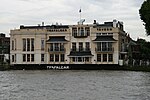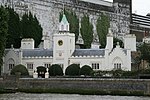Millwall Iron Works
The Millwall Iron Works, London, England, was a 19th-century industrial complex and series of companies, which developed from 1824. Formed from a series of small shipbuilding companies to address the need to build larger and larger ships, the holding company collapsed after the Panic of 1866 which greatly reduced shipbuilding in London. Subsequently, a recovery was made by a series of smaller companies, but by the later 19th century the location was too small for the building of ships on the scale then required. Most of its buildings, being near the apex of the peninsula in the Isle of Dogs, survived the Blitz and have been made into apartment blocks in a residential estate, Burrells Wharf.
Excerpt from the Wikipedia article Millwall Iron Works (License: CC BY-SA 3.0, Authors).Millwall Iron Works
Glenaffric Avenue, London Isle of Dogs
Geographical coordinates (GPS) Address Nearby Places Show on map
Geographical coordinates (GPS)
| Latitude | Longitude |
|---|---|
| N 51.488691666667 ° | E -0.0056638888888889 ° |
Address
The Waterman's Arms
Glenaffric Avenue 1
E14 3BW London, Isle of Dogs
England, United Kingdom
Open on Google Maps









